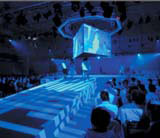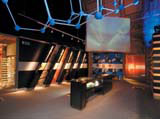Light touch

Lighting design is often overlooked and undervalued, yet the right effect can transform an exhibit by showing it to its best possible advantage. Pamela Buxton brings lighting designers out of the shadows
‘You might spend a week hanging a show and two weeks trying to light it. Lighting design has to be the hardest part of staging a show,’ says Jenny Blythe. A former curator of London’s Saatchi Gallery, she has collaborated with sculptor Gerry Judah on his current exhibition, Frontiers in North London. It took several attempts to find an unobtrusive light solution for the all-white, 3D gesso models mounted on canvas. Eventually, lighting design group Halo came up trumps, installing a new lighting track from a series of suspended fluorescent rods, to achieve the required effect of northern light with uni-directional soft shadows. ‘You can’t beat daylight, but this is the nearest you can get without putting in huge film-lighting,’ says Judah.
Judah, who has also worked as a set designer for stage and screen, is no stranger to the need to persevere, in order to achieve just the right effect. With the agreement of his client, he once scrapped a £15 000 lighting installation of his sculpture at Goodwood and started again, when it failed to measure up to expectations.
In an ideal world, this kind of attention would always be lavished on lighting. ‘I don’t think the lighting can be skimped on,’ says Debby Kuypers of architect and exhibition design consultancy RFK, which has just worked with lighting specialist LAPD on Tate Britain’s current Degas Sickert Toulouse-Lautrec exhibition. ‘If you have an in-house designer who can do it, there’s no need to get a consultant in, but it’s a shame if it’s done by technicians or electricians,’ says Kuypers.
But, for many low-budget productions, it’s a struggle to procure any designated lighting design budget at all. As Nick Coombe, of architect and exhibition design group Stickland Coombe, says, ‘They can hardly afford to pay us. There’s no meat left on the bone for any one else.’ The only thing for it, he says, is to be ‘very resourceful’.
With little money or time, and often little control over the environment or communication between the project team, it’s no wonder that lighting design can go awry – especially if the diverse nature of the exhibits calls for a lighting designer with broad experience. RFK and LAPD met this challenge with the Degas Sickert Toulouse-Lautrec show, where exhibits varied from heavy oils to watercolours. ‘It’s a challenge to ensure that visitors don’t notice when lighting exhibits require different lux levels,’ says Kuypers. ‘Pastels and watercolours, for example, can’t take more than 50 watts.’
‘Unless you have a brand new museum, with brand new equipment, it’s always a challenge,’ says Durham Marenghi, who specialises in lighting live shows, but also lights many exhibitions at the Design Museum, including the current Eileen Gray exhibition. For this, several of the roomsets involved fragile objects that couldn’t take more than 50 lux of light, requiring lenses that diffused the light and brought levels down.
Sometimes, the limitations of the host museum’s lighting call for ingenious solutions. When Marenghi designed lighting for the Marc Newson show earlier last year, he was unable to illuminate the front of a model jet with the rig provided. Instead, he achieved the desired effect by placing an angled mirror in the nose of the jet and bouncing light off that.
‘The most important thing about lighting exhibitions is that you’re not aware of the lighting. So often it’s too in your face,’ says Emma Dawson-Tarr, managing director of Absolute Action, which supplied fibre-optic lighting for the Diamonds exhibition at the Natural History Museum, designed by Real Time and lighting designer DHA. ‘But it costs money. It would pay for museums to get the right system and training in place at the onset,’ she says.

Whatever the budget and equipment, the key to successfully lighting a temporary show is communication, according to Tanya Burns, one of three lighting designers at Imagination. Typically, her projects are major car launches, often in spaces with little infrastructure. ‘The most important thing is to facilitate communication between the different members of the design team and the client,’ she says. ‘Often, with temporary exhibitions, the issue is about controlling the environment for the lighting – lighting truss, generators, even cleaners. Lighting only exists courtesy of everyone’s kindness.’
Despite the constraints and low budgets, temporary exhibitions are popular with lighting designers, who enjoy the challenge and profile they bring. ‘I wouldn’t make a living doing Design Museum exhibitions, but I enjoy it and it’s important,’ says Marenghi. ‘If people go to the effort of putting on an exhibition, it needs to be lit well.’ l
-
Post a comment




